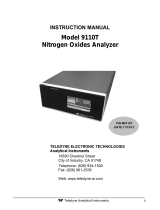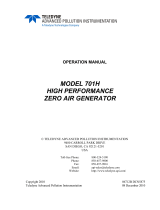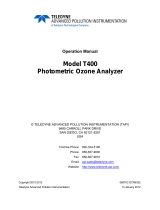Page is loading ...

Manual Addendum
Model T265
Chemiluminescence Ozone Analyzer
(Addendum to Model T200 Operation Manual PN 06858)
© TELEDYNE ADVANCED POLLUTION INSTRUMENTATION
9480 CARROLL PARK DRIVE
SAN DIEGO, CA 92121-5201
USA
Toll-free Phone: 800-324-5190
Phone: 858-657-9800
Fax: 858-657-9816
Email: [email protected]
Website: http://www.teledyne-api.com/
Copyright 2011 07337B DCN6324
Teledyne Advanced Pollution Instrumentation December 07, 2011


i
IMPORTANT SAFETY INFORMATION
Important safety messages are provided throughout this manual for the purpose of
avoiding personal injury or instrument damage. Please read these messages carefully.
Each safety message is associated with a safety alert symbol and placed throughout this
manual and inside the instrument. The symbols with messages are defined as follows:
WARNING: Electrical Shock Hazard
HAZARD: Strong oxidizer
GENERAL WARNING/CAUTION: Read the accompanying message for specific
information.
CAUTION: Hot Surface Warning
Do Not Touch: Touching some parts of the instrument without protection or proper
tools could result in damage to the part(s) and/or the instrument.
Technician Symbol: All operations marked with this symbol are to be performed by
qualified maintenance personnel only.
Electrical Ground: This symbol inside the instrument marks the central safety
grounding point for the instrument.
CAUTION
This instrument should only be used for the purpose and in the manner
described in this manual. If you use this instrument in a manner other than
that for which it was intended, unpredictable behavior could ensue with
possible hazardous consequences
.
NEVER use any gas analyzer to sample combustible gas(es)!
Note
For Technical Assistance regarding the use and maintenance of this
instrument or any other Teledyne API product, contact Teledyne API’s
Customer Service Department:
Phone: 800-324-5190
Email: [email protected]
or by accessing various service options on our website at
http://www.teledyne-api.com/.
07337B DCN6324

ii
CONSIGNES DE SÉCURITÉ
Des consignes de sécurité importantes sont fournies tout au long du présent manuel dans
le but d’éviter des blessures corporelles ou d’endommager les instruments. 1tée par un
pictogramme d’alerte de sécurité; ces pictogrammes se retrouvent dans ce manuel et à
l’intérieur des instruments. Les symboles correspondent aux consignes suivantes :
AVERTISSEMENT : Risque de choc électrique
DANGER : Oxydant puissant
AVERTISSEMENT GÉNÉRAL / MISE EN GARDE : Lire la
consigne complémentaire pour des renseignements spécifiques
MISE EN GARDE : Surface chaude
Ne pas toucher : Toucher à certaines parties de l’instrument sans
protection ou sans les outils appropriés pourrait entraîner des
dommages aux pièces ou à l’instrument.
Pictogramme « technicien » : Toutes les opérations portant ce
symbole doivent être effectuées uniquement par du personnel de
maintenance qualifié.
Mise à la terre : Ce symbole à l’intérieur de l’instrument détermine le
point central de la mise à la terre sécuritaire de l’instrument.
MISE EN GARDE
Cet instrument doit être utilisé aux fins décrites et de la manière
décrite dans ce manuel. Si vous utilisez cet instrument d’une autre
manière que celle pour laquelle il a été prévu, l’instrument pourrait se
comporter de façon imprévisible et entraîner des conséquences
dangereuses.
NE JAMAIS utiliser un analyseur de gaz pour échantillonner des gaz
combustibles!
07337B DCN6324

iii
ABOUT THIS MANUAL
This addendum is to be used in conjunction with the T200 Operation Manual, PN
06858.
REVISION HISTORY
This section provides information regarding changes to this manual.
2011 December 07, Model T265 Addendum,
Rev DCN Description of Changes
B 6324 Specs update: Zero Noise, LDL, Zero and Span Drifts
2011 November 08, T265 Addendum, PN07337A, DCN6120, Initial Release
07337B DCN6324

iv
This page intentionally left blank.
07337B DCN6324

v
TABLE OF CONTENTS
IMPORTANT SAFETY INFORMATION .......................................................................................................................I
ABOUT THIS MANUAL.................................................................................................................................................III
REVISION HISTORY .....................................................................................................................................................III
TABLE OF CONTENTS....................................................................................................................................................V
1. INTRODUCTION......................................................................................................................................................7
1.1 OVERVIEW...........................................................................................................................................................7
2. SPECIFICATIONS, APPROVALS, & CERTIFICATIONS.................................................................................9
2.1 EPA DESIGNATION ............................................................................................................................................11
2.2 COMPLIANCE STATEMENTS ...............................................................................................................................11
2.2.1 Safety............................................................................................................................................................11
2.2.2 EMC.............................................................................................................................................................11
2.3 WARRANTY .......................................................................................................................................................11
3. GETTING STARTED..............................................................................................................................................13
3.1 UNPACKING .......................................................................................................................................................13
3.2 INSTRUMENT LAYOUT .......................................................................................................................................15
3.2.1 Front Panel .......................................................................................................................................................15
3.2.2 Rear Panel.........................................................................................................................................................16
3.2.3 Internal Chassis Layout.....................................................................................................................................17
3.3 CONNECTIONS AND SETUP .................................................................................................................................18
3.3.1 Electrical and Pneumatic Connections.......................................................................................................18
3.4 STARTUP, FUNCTIONAL CHECKS, AND INITIAL CALIBRATION ...........................................................................20
3.4.1 Startup...............................................................................................................................................................20
3.4.2 Initial Calibration..............................................................................................................................................20
4. MAINTENANCE .....................................................................................................................................................23
4.1 MAINTENANCE SCHEDULE.................................................................................................................................23
4.2 MAINTENANCE ITEMS SPECIFIC TO THE MODEL T265 .......................................................................................23
5. PRINCIPLES OF OPERATION............................................................................................................................25
LIST OF FIGURES
FIGURE 3-1. FRONT PANEL ............................................................................................................15
FIGURE 3-2. REAR PANEL ..............................................................................................................16
FIGURE 3-3. INTERNAL CHASSIS LAYOUT ................................................................................17
FIGURE 3-4. T265 PNEUMATICS
, BASIC CONFIGURATION ....................................................19
LIST OF TABLES
TABLE 2-1. MODEL T265 SPECIFICATIONS ................................................................................10
07337B DCN6324

vi
This page intentionally left blank.
07337B DCN6324

7
1. INTRODUCTION
This section presents a brief overview of the Model T265; supplemental information
may be found in the Model T200 Operation Manual.
1.1 OVERVIEW
The Model T265 is a close derivative of the Model T200 Chemiluminescence NOx
Analyzer. This addendum provides an overview of the instrument with details of the
features and functions that are specific to the Model T265; it is intended as a
supplement to the Model T200 operation manual (Teledyne API part number 06858).
Note: it is imperative that before placing the analyzer into service, users familiarize
themselves with the Model T200 manual, which describes in detail specific
functionality common to both products, such as hardware adjustment during calibration,
initializing communications with the product and trouble-shooting approaches.
07337B DCN6324

Introduction Model T265 Chemiluminescence Ozone Analyzer Addendum to Model T200 Manual
8
This page intentionally left blank.
07337B DCN6324

Specifications, Approvals, & Certifications Model T265 Chemiluminescence Ozone Analyzer Addendum to Model T200 Manual
10
Table 2-1. Model T265 Specifications
PARAMETER SPECIFICATION
Ranges 0-100 ppb to 0-2,000 ppb full scale, user selectable.
Measurement Mode Single Range or AutoRange
Measurement Units ppb, ppm,
µg/m
3
mg/m
3
Zero Noise
1
<0.15 ppb (RMS)
Span Noise
1
<0.5% of reading (RMS) above 100 ppb
Lower Detectable Limit <0.3 ppb
Zero Drift (24 hours) <0.5 ppb
Span Drift (24 hours) <0.5% of full scale
Linearity <1% of full scale
Precision <0.5% of reading
Lag Time
1
<10 sec
Rise/Fall Time
1
<20 sec to 95%
Sample Flow Rate 500 cm³/min ± 10%
Reagent Gas NO at 10,000 ppm ±10%
Reagent Flow 5 ± 2 cm³/min
Installation Category (Over-voltage Category) II Environmental
Pollution Degree 2
Temperature Range 5 – 40° C (with EPA equivalency)
Humidity Range 10-90% RH non-condensing
Dimensions H x W x D 7" x 17" x 23.5" (18 cm x 43 cm x 61 cm)
Weight, Analyzer 40 lbs (18 kg) (with internal pump)
AC Power 100 V – 120 V, 60Hz (3.0 A)
220 V – 240 V, 50 Hz (2.5 A)
Analog Output Ranges All Outputs: 100 mV, 1 V, 5 V, 10 V
Two concentration outputs convertible to 4-20 mA isolated current loop
(option)
All Ranges with 5% Under/Over Range
Analog Output Resolution 1 part in 4096 of selected full scale voltage
Standard I/O
1 Ethernet: 10/100Base-T
2 RS-232 (300 – 115,200 baud)
2 USB device ports
8 opto-isolated digital status outputs
6 opto-isolated digital control inputs
4 analog outputs
Optional I/O
1 USB com port
1 RS485
8 analog inputs (0-10V, 12-bit)
4 digital alarm outputs
Multidrop RS232
3 4-20mA current outputs
1
As defined by the US EPA
07337B DCN6324

Model T265 Chemiluminescence Ozone Analyzer Addendum to Model T200 Manual Specifications, Approvals, &
Certifications
11
2.1 EPA DESIGNATION
Teledyne API’s Model T265 Chemiluminescence Ozone Analyzer received EPA
approval for Designation
EQOA-0611-199. The designation will be considered valid
when operated under the following conditions:
on any full scale range between 0-100 ppb and 0-1000 ppb
with any range mode (Single, Dual, or AutoRange)
at any ambient temperature in the range of 5°C to 40°C
with a TFE filter in the sample air inlet
with a sample flow rate of 500 ± 50 cm3/min (sea level)
with the dilution factor set to 1
with Temp/Press compensation ON
in accordance with the appropriate associated instrument manuals
with or without any of the following options:
Internal or external sample pump
Sample/Cal valve option
Rack mount with or without slides
Analog input option
4-20 mA isolated current loop output
2.2 APPROVALS AND CERTIFICATIONS
The Teledyne - API Model T265 analyzer was tested and certified for Safety and
Electromagnetic Compatibility (EMC). This section presents the compliance
statements for those requirements and directives.
2.2.1 Safety
IEC 61010-1:2001, Safety requirements for electrical equipment for measurement,
control, and laboratory use.
CE: 2006/95/EC, Low-Voltage Directive
North American:
cNEMKO (Canada): CAN/CSA-C22.2 No. 61010-1-04
NEMKO-CCL (US): UL No. 61010-1 (2nd Edition)
2.2.2 EMC
EN 61326-1 (IEC 61326-1), Class A Emissions/Industrial Immunity
EN 55011 (CISPR 11), Group 1, Class A Emissions
FCC 47 CFR Part 15B, Class A Emissions
CE: 2004/108/EC, Electromagnetic Compatibility Directive
2.3 WARRANTY
Refer to the Model T200 operation manual regarding the Warranty policy for the
Model T265.
07337B DCN6324

Specifications, Approvals, & Certifications Model T265 Chemiluminescence Ozone Analyzer Addendum to Model T200 Manual
12
This page intentionally left blank.
07337B DCN6324

13
3. GETTING STARTED
This section addresses the procedures for unpacking the instrument and inspecting for
damage, and introduces the instrument layout, then presents the procedures for getting
started: making electrical and pneumatic connections, and conducting an initial
calibration check. Please see the Model T200 Operation Manual for more information.
3.1 UNPACKING
CAUTION – GENERAL SAFETY HAZARD
To avoid personal injury, always use two persons to lift and carry the Model T265.
ATTENTION
COULD DAMAGE INSTRUMENT AND VOID WARRANTY
Printed Circuit Assemblies (PCAs) are sensitive to electro-static
discharges too small to be felt by the human nervous system. Failure
to use ESD protection when working with electronic assemblies will
void the instrument warranty
See A Primer on Electro-Static Discharge in the accompanying Model
T200 manual for more information on preventing ESD damage.
CAUTION - ELECTRICAL SHOCK HAZARD
Never disconnect PCAs, wiring harnesses or electronic subassemblies while
analyzer is under power.
07337B DCN6324

Getting Started Model T265 Chemiluminescence Ozone Analyzer Addendum to Model T200 Manual
14
CAUTION
Remove dust plugs from pneumatic fittings on the rear panel of the analyzer,
prior to applying power to the analyzer.
Note
It is recommended that you store shipping containers/materials for
future use if/when the instrument should be returned to the factory for
repair and/or calibration service. See Warranty section in this manual
and shipping procedures on our Website at http://www.teledyne-api.com
under Customer Support > Return Authorization.
1. First, verify that there is no apparent external shipping damage. If damage
has occurred, please advise the shipper first, then Teledyne-API. Save the
packaging for shipper’s examination.
2. Included with your analyzer is a printed record of the final performance
characterization performed on your instrument at the factory. This record,
titled Final Test and Validation Data Sheet (P/N 06627) is an important
quality assurance and calibration record for this instrument. It should be
placed in the quality records file for this instrument.
3. Carefully remove the top cover of the analyzer and check for internal
shipping damage.
Remove the set screw located in the top, center of the front panel.
Remove the two screws fastening the top cover to the unit (one per side
towards the rear).
Slide the cover backward until it clears the analyzer’s front bezel.
Lift the cover straight up.
Check for internal shipping damage, and generally inspect the interior
of the instrument to make sure all circuit boards and other components
are in good shape and properly seated.
4. Reinstall the cover and screws, once the inspection is complete.
5. Check the voltage and frequency label on the serial number tag on the rear
panel. Compare that to your local power before plugging the instrument
into an outlet.
07337B DCN6324

Model T265 Chemiluminescence Ozone Analyzer Addendum to Model T200 Manual Getting Started
15
3.2 INSTRUMENT LAYOUT
Instrument layout includes front panel and display, rear panel connectors, and internal
chassis layout.
3.2.1 Front Panel
Figure 3-1 illustrates the front panel of the Model T265 analyzer.
Figure 3-1. Front Panel
07337B DCN6324

Getting Started Model T265 Chemiluminescence Ozone Analyzer Addendum to Model T200 Manual
18
3.3 CONNECTIONS AND SETUP
This section presents connection information for setting up the instrument to operate.
3.3.1 Electrical and Pneumatic Connections
1. Refer to Figure 3-2 for the rear panel electrical and pneumatic connectors.
2. Mount the NOx scrubber with base down (arrow labeled “FLOW” pointing
down) onto the rear panel.
3. Connect tubing from NOx scrubber base fitting to rear panel fitting labeled
“FROM SCRUBBER”.
4. Connect tubing from NOx scrubber top fitting to rear panel fitting labeled
“TO SCRUBBER”.
5. Vent the EXHAUST port to atmospheric pressure and out of the room,
because of its nitric oxide content.
6. Attach the sample inlet line to the sample inlet port. The pressure of the
sample gas at the inlet port should be at ambient pressure and constant.
7. Using 1/8” stainless steel tubing, attach a cylinder with 10,000 ppm ±10%
of nitric oxide (NO) in nitrogen (N2), with an appropriate pressure
regulator, to the 1/8” stainless steel port (labeled NITRIC OXIDE) on the
rear panel as shown in Figure 3-2. Note: The NO cylinder’s pressure
regulator should be set to deliver gas at 20 PSIG ± 5 PSIG.
8. Attach a strip chart recorder and/or data-logger to the appropriate analog
output connections on the rear panel. See section on analog output
connections in the Model T200 manual for connector pin-out definitions.
9. Connect the power cord to the correct line voltage.
WARNING
Lethal voltages present inside the analyzer’s case.
Do not operate with cover off during normal operation.
Before operation, check for correct input voltage and frequency.
Do not operate without proper chassis grounding.
Do not defeat the ground wire on power plug.
Turn off analyzer power before disconnecting electrical subassemblies.
CAUTION
GENERAL SAFETY HAZARD
Analyzer Exhaust Contains Nitric Oxide Gas.
Vent pump exhaust to a well-ventilated area at atmospheric pressure.
Obtain a Material Safety Data Sheet (MSDS) for this material. Read and
rigorously follow the safety guidelines described there.
07337B DCN6324
/












